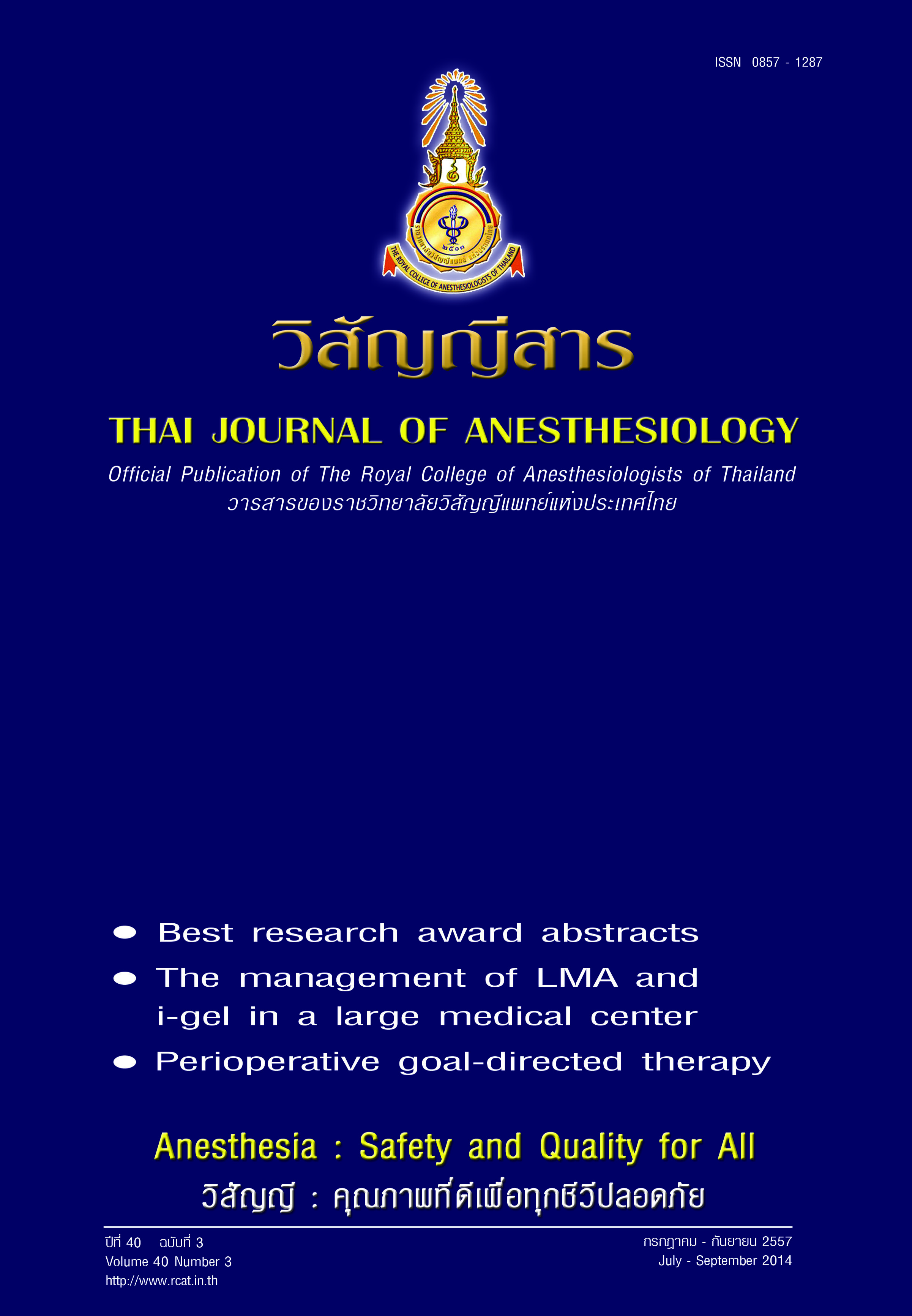The Effect of Pre - incisional Anterior Scalp Blockade with 0.5% Bupivacaine on Perioperative Outcomes in Patients Scheduled for Supratentorial Craniotomy surgery: A Prospective Randomized Double - Blind, Placebo - Controlled Study
Main Article Content
Abstract
Background: The effect of scalp blockade is inconclusive. The main purpose of pre - incisional scalp block is to attenuate the hemodynamic response during the skull pin insertion, which is the strongest surgical stimulus before the operation begins.
Objective: The aims of this study are to examine the benefits of a pre - incisional anterior scalp blockade with 0.5% bupivacaine as an intraoperative fentanyl requirement, hemodynamic change during skull pin application, and the rate of immediate postoperative extubation.
Method: The study design is a prospective randomized double blind, placebo controlled trial. Ninety - five patients were enrolled and randomly divided to a bupivacaine scalp block group (N = 51) and a normal saline scalp block group or control group (N = 44).
Result: The intraoperative fentanyl requirement of the patients in the bupivacaine scalp block group was 5.8 ± 3.0 μg/kg and that of the patients in the control group was 6.4 ± 3.2 μg/kg (p = 0.33). The increase of mean arterial pressure during the skull pin application was greater in the control group, especially in patients with underlyinghypertensive disease (14 ± 7 mmHg versus 11 ± 9 mmHg, p = 0.38). However, the differences did not reach a statistical significance. The rate of immediate extubation is comparable between two groups.
Conclusion: Our study failed to demonstrate statistically significant benefits of the pre-incisional anterior scalp blockade with 0.5% bupivacaine.
การศึกษาผลของการสกัดเส้นประสาทของหนังศีรษะด้วยยาชาบูพิวาเคนความเข้มข้นร้อยละ 0.5 ต่อผลลัพธ์ระหว่างและหลังผ่าตัดสมอง: การศึกษาแบบสุ่ม ไปข้างหน้า แบบมีกลุ่มควบคุมและบดบังวิธีการศึกษาต่อผู้ป่วยและผู้ประเมินผลการวิจัย
บทนำ: การสกัดเส้นประสาทหนังศีรษะก่อนการผ่าตัดสมอง เป็นวิธีการลดความเจ็บปวดจากการผ่าตัดสมองวิธีหนึ่ง อย่างไรก็ตามจากผลการศึกษาประโยชน์จากการสกัดเส้นประสาทหนังศีรษะของหลาย ๆ การศึกษาที่ผ่านมายังไม่ได้ข้อสรุปที่ตรงกัน การศึกษาครั้งนี้จึงได้จัดทำขึ้นโดยมีวัตถุประสงค์เพื่อศึกษาผลของการสกัดเส้นประสาทหนังศีรษะด้วยยาชาบูพิวาเคนความเข้มข้นร้อยละ 0.5 ต่อปริมาณความต้องการใช้ยาเฟนทานิลระหว่างการผ่าตัด การเปลี่ยนแปลงของระบบไหลเวียนโลหิตในช่วงการใส่อุปกรณ์ยึดศีรษะ ผู้ป่วยกับเตียงผ่าตัดและอัตราการถอดท่อช่วยหายใจเมื่อผ่าตัดเสร็จ โดยทำการศึกษาแบบสุ่ม ไปข้างหน้า มีกลุ่มควบคุมและบดบังวิธีการศึกษาต่อผู้ป่วยและผู้ประเมินผลการวิจัย เก็บข้อมูลจากอาสาสมัครที่มาเข้ารับการผ่าตัดสมองแบบนัดหมายล่วงหน้า จำนวน 95 ราย
ผลการศึกษา: พบว่าความต้องการใช้ยาเฟนทานิลระหว่างกลุ่มที่ได้รับการสกัดเส้นประสาทหนังศีรษะด้วยยาชาบูพิวาเคนเปรียบเทียบกับกลุ่มควบคุม คือ 5.8 ± 3.0 ไมโครกรัม/ กิโลกรัมและ 6.4 ± 3.2 ไมโครกรัม/ กิโลกรัม (p = 0.33) การเปลี่ยนแปลงค่าเฉลี่ย ความดันโลหิตขณะใส่อุปกรณ์ยึดศีรษะผู้ป่วยกับเตียงผ่าตัดในกลุ่มควบคุมสูงกว่าในกลุ่มที่ได้รับการสกัดเส้นประสาทหนังศีรษะด้วยยาชาบูพิวาเคน (14 ± 7 มิลลิเมตรปรอทเปรียบเทียบกับ 11 ± 9 มิลลิเมตรปรอท, p = 0.38) และพบว่าอัตราการถอดท่อช่วยหายใจเมื่อผ่าตัดเสร็จไม่แตกต่างกันระหว่างกลุ่มที่ได้รับการสกัดเส้นประสาทหนังศีรษะด้วยยาชาบูพิวาเคนกับกลุ่มควบคุม
สรุป: การศึกษาครั้งนี้ไม่พบว่าการสกัด เส้นประสาทหนังศีรษะก่อนการผ่าตัดสมอง ด้วยยาชาบูพิวาเคนความเข้มข้นร้อยละ 0.5 มีประโยชน์มากไปกว่าการได้รับยาแก้ปวดทางหลอดเลือดดำเพียงอย่างเดียว


